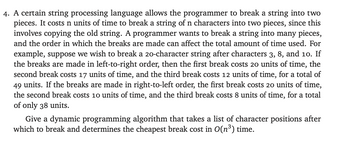
Database System Concepts
7th Edition
ISBN: 9780078022159
Author: Abraham Silberschatz Professor, Henry F. Korth, S. Sudarshan
Publisher: McGraw-Hill Education
expand_more
expand_more
format_list_bulleted
Question
-
Solutions to a dynamic
programming problem have (at minimum) three things: – A recurrence relation– A brief description of what your recurrence function represents and what each case represents.
– A brief description of the memory element/storage and how it’s filled in.
– Always give complete solutions, not just examples.
– Always declare all your variables, in English. In particular, always describe the specific- problem your
algorithm is supposed to solve. – Never use weak induction.

Transcribed Image Text:4. A certain string processing language allows the programmer to break a string into two
pieces. It costs n units of time to break a string of n characters into two pieces, since this
involves copying the old string. A programmer wants to break a string into many pieces,
and the order in which the breaks are made can affect the total amount of time used. For
example, suppose we wish to break a 20-character string after characters 3, 8, and 10. If
the breaks are made in left-to-right order, then the first break costs 20 units of time, the
second break costs 17 units of time, and the third break costs 12 units of time, for a total of
49 units. If the breaks are made in right-to-left order, the first break costs 20 units of time,
the second break costs 10 units of time, and the third break costs 8 units of time, for a total
of only 38 units.
Give a dynamic programming algorithm that takes a list of character positions after
which to break and determines the cheapest break cost in O(n³) time.
Expert Solution
This question has been solved!
Explore an expertly crafted, step-by-step solution for a thorough understanding of key concepts.
This is a popular solution
Trending nowThis is a popular solution!
Step by stepSolved in 1 steps

Knowledge Booster
Similar questions
- Give a recursive definition for the set of all strings of a’s and b’s that begins with an a and ends in a b. Say, S = { ab, aab, abb, aaab, aabb, abbb, abab..} Let S be the set of all strings of a’s and b’s that begins with a and ends in a b. The recursive definition is as follows – Base:... Recursion: If u ∈ S, then... Restriction: There are no elements of S other than those obtained from the base and recursion of S.arrow_forwardI need the answer as soon as possiblearrow_forwardWrite a recursive function, numMoves(), that takes a number representing the number of disks in the Hanoi problem, and returns the number of moves involved. I recommend you start writing this function by modifying the hanoi.py program given. Test cases: numMoves(3) should return 7 and numMoves(4) should return 15. Do not use any global variables. hanoi.pyarrow_forward
Recommended textbooks for you
 Database System ConceptsComputer ScienceISBN:9780078022159Author:Abraham Silberschatz Professor, Henry F. Korth, S. SudarshanPublisher:McGraw-Hill Education
Database System ConceptsComputer ScienceISBN:9780078022159Author:Abraham Silberschatz Professor, Henry F. Korth, S. SudarshanPublisher:McGraw-Hill Education Starting Out with Python (4th Edition)Computer ScienceISBN:9780134444321Author:Tony GaddisPublisher:PEARSON
Starting Out with Python (4th Edition)Computer ScienceISBN:9780134444321Author:Tony GaddisPublisher:PEARSON Digital Fundamentals (11th Edition)Computer ScienceISBN:9780132737968Author:Thomas L. FloydPublisher:PEARSON
Digital Fundamentals (11th Edition)Computer ScienceISBN:9780132737968Author:Thomas L. FloydPublisher:PEARSON C How to Program (8th Edition)Computer ScienceISBN:9780133976892Author:Paul J. Deitel, Harvey DeitelPublisher:PEARSON
C How to Program (8th Edition)Computer ScienceISBN:9780133976892Author:Paul J. Deitel, Harvey DeitelPublisher:PEARSON Database Systems: Design, Implementation, & Manag...Computer ScienceISBN:9781337627900Author:Carlos Coronel, Steven MorrisPublisher:Cengage Learning
Database Systems: Design, Implementation, & Manag...Computer ScienceISBN:9781337627900Author:Carlos Coronel, Steven MorrisPublisher:Cengage Learning Programmable Logic ControllersComputer ScienceISBN:9780073373843Author:Frank D. PetruzellaPublisher:McGraw-Hill Education
Programmable Logic ControllersComputer ScienceISBN:9780073373843Author:Frank D. PetruzellaPublisher:McGraw-Hill Education

Database System Concepts
Computer Science
ISBN:9780078022159
Author:Abraham Silberschatz Professor, Henry F. Korth, S. Sudarshan
Publisher:McGraw-Hill Education

Starting Out with Python (4th Edition)
Computer Science
ISBN:9780134444321
Author:Tony Gaddis
Publisher:PEARSON

Digital Fundamentals (11th Edition)
Computer Science
ISBN:9780132737968
Author:Thomas L. Floyd
Publisher:PEARSON

C How to Program (8th Edition)
Computer Science
ISBN:9780133976892
Author:Paul J. Deitel, Harvey Deitel
Publisher:PEARSON

Database Systems: Design, Implementation, & Manag...
Computer Science
ISBN:9781337627900
Author:Carlos Coronel, Steven Morris
Publisher:Cengage Learning

Programmable Logic Controllers
Computer Science
ISBN:9780073373843
Author:Frank D. Petruzella
Publisher:McGraw-Hill Education